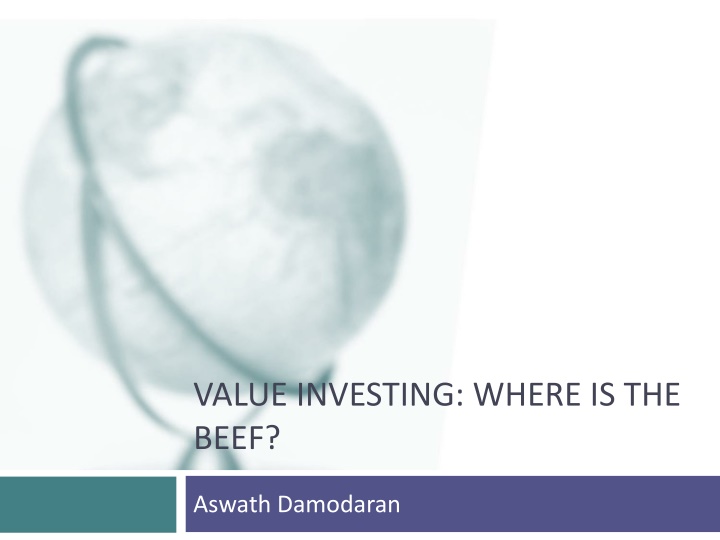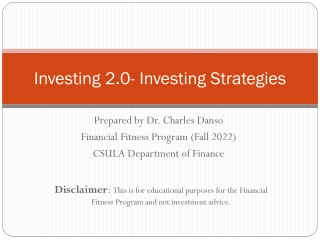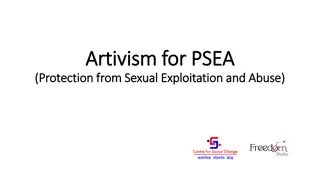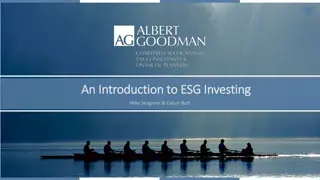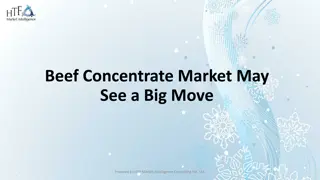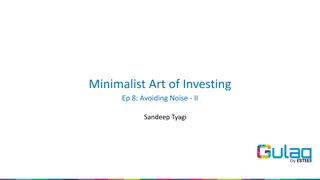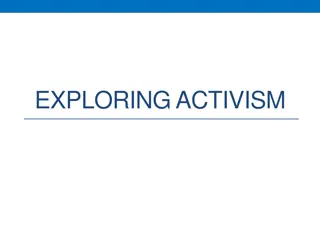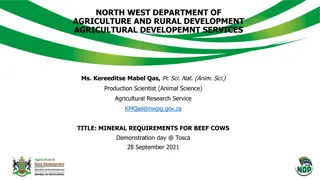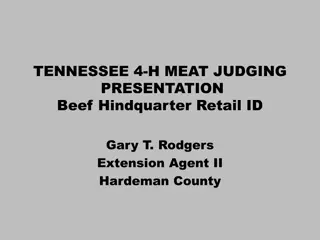Value Investing: Where is the Beef? Payoff, Activism, and Rigid Strategies
The article explores the weak payoff of active value investing, the varying success of growth vs. value investors, individual investor performance, activism in the market, and the three big Rs of value investing - Rigid strategies, Returns, and Risks.
Download Presentation

Please find below an Image/Link to download the presentation.
The content on the website is provided AS IS for your information and personal use only. It may not be sold, licensed, or shared on other websites without obtaining consent from the author.If you encounter any issues during the download, it is possible that the publisher has removed the file from their server.
You are allowed to download the files provided on this website for personal or commercial use, subject to the condition that they are used lawfully. All files are the property of their respective owners.
The content on the website is provided AS IS for your information and personal use only. It may not be sold, licensed, or shared on other websites without obtaining consent from the author.
E N D
Presentation Transcript
VALUE INVESTING: WHERE IS THE BEEF? Aswath Damodaran
The payoff to institutional active value investing is weak.. If value investing is the best way to invest , how do we explain the fact that active growth investors beat a passive growth index fund far more frequently and by far more than active value investors do, relative to a passive value fund? ? 2
And only slightly stronger for active individual investors Average underperformance: In a study of individual brokerage accounts between 1991-96, the average individual investor under performed the S&P 500 by about 1% and that the degree of under performance increased with trading activity. Heavily skewed: The top-performing quartile in the study referenced above outperformed the market by about 6%. Another study of 16,668 individual trader accounts at a large discount brokerage house finds that the top 10 percent of traders in this group outperform the bottom 10 percent by about 8 percent per year over a long period. Home bias and concentration? Studies of individual investors find that they generate relatively high returns when they invest in companies close to their homes compared to the stocks of distant companies, and that investors with more concentrated portfolios outperform those with more diversified portfolios. Less (trading) is more (return): While none of these studies of individual investors classify the superior investors by investment philosophy, the collective finding that these investors tend not to trade much and have concentrated portfolios can be viewed as evidence (albeit weak) that they are more likely to be value investors. 3
Some activists do well, but activism is often a zero sum game Overall returns: Activist mutual funds seem to have had the lowest payoff to their activism, with little change accruing to the corporate governance, performance or stock prices of targeted firms. Activist hedge funds, on the other hand, seem to earn substantial excess returns, ranging from 7- 8% on an annualized basis at the low end to 20% or more at the high end. Individual activists seem to fall somewhere in the middle, earning higher returns than institutions but lower returns than hedge funds. Volatility in returns: While the average excess returns earned by hedge funds and individual activists is positive, there is substantial volatility in these returns and the magnitude of the excess return is sensitive to the benchmark used and the risk adjustment process. Skewed distributions: The average returns across activist investors obscures a key component, which is that the distribution is skewed with the most positive returns being delivered by the activist investors in the top quartile; the median activist investor may very well just break even, especially after accounting for the cost of activism. 4
The three biggest Rs of value investing Rigid: The strategies that have come to characterize a great deal of value investing reveal an astonishing faith in accounting numbers and an equally stunning lack of faith in markets getting anything right. Value investors may be the last believers in book value. The rigidity extends to the types of companies that you buy (avoiding entire sectors ) Righteous: Value investors have convinced themselves that they are better people than other investors. Index fund investors are viewed as academic stooges , growth investors are considered to be dilettantes and momentum investors are lemmings . Value investors consider themselves to be the grown ups in the investing game. Ritualistic: Modern day value investing has a whole menu of rituals that investors have to perform to meet be value investors . The rituals range from the benign (claim to have read Security Analysis by Ben Graham and every Berkshire Hathaway annual report) to the not-so-benign 5
Myth 1: DCF valuation is an academic exercise The value of an asset is the present value of the expected cash flows on that asset, over its expected life: Proposition 1: If it does not affect the cash flows or alter risk (thus changing discount rates), it cannot affect value. Proposition 2: For an asset to have value, the expected cash flows have to be positive some time over the life of the asset. Proposition 3: Assets that generate cash flows early in their life will be worth more than assets that generate cash flows later; the latter may however have greater growth and higher cash flows to compensate. 6
Myth 2: Beta is greek from geeksand essential to DCF valuation Dispensing with all of the noise, here are the underpinnings for using beta as a measure of risk: Risk is measured in volatility in asset prices The risk in an individual investment is the risk that it adds to the investor s portfolio That risk can be measured with a beta (CAPM) or with multiple betas (in the APM or Multi-factor models) 1. Beta is a measure of relative risk: Beta is a way of scaled risk, with the scaling around one. Thus, a beta of 1.50 is an indication that a stock is 1.50 times as risky as the average stock, with risk measured as risk added to a portfolio. 2. Beta measures exposure to macroeconomic risk: Risk that is specific to individual companies will get averaged out (some companies do better than expected and others d worse). The only risk that you cannot diversify away is exposure to macroeconomic risk, which cuts across most or all investments. 7
Myth 3: The Margin of Safety is an alternative to beta and works. The margin of safety is a buffer that you build into your investment decisions to protect yourself from investment mistakes. Thus, if your margin of safety is 30%, you will buy a stock only if the price is more than 30% below its intrinsic value. There is nothing wrong with using the margin of safety as an additional risk measure, as long as the following are kept in mind: Proposition 1: MOS comes into play at the end of the investment process, not at the beginning. Proposition 2: MOS does not substitute for risk assessment and intrinsic valuation, but augments them. Proposition 3: The MOS cannot and should not be a fixed number, but should be reflective of the uncertainty in the assessment of intrinsic value. Proposition 4: Being too conservative can be damaging to your long term investment prospects. Too high a MOS can hurt you as an investor. 8
Myth 4: Good management = Low Risk Risk is about how companies do, relative to expectations. To the extent that expectations are set too high for good managers, firms that are well managed may be more risky than badly managed firms, where little is expected of the company. Thus, rather than think about risk in absolute terms, we should be thinking in relative terms, i.e., what are the results likely to be relative to expectations? In fact, given the fuzzy definitions that many value investors attach to good management, it is likely that screening for it is more likely to create harm than good. 9
Myth 5: Wide moats = Good investments Moats are the competitive advantages that allow companies to generate keep the competition out. In the process, they can keep their margins and returns high and improve the quality of their growth. Intrinsic value people and value investors do agree that moats matter to value: the wider the moat, the higher the value added by growth. But there are two places where they might disagree: Moats matter more for growth companies than mature companies: Wide moats increase the value of companies and the value increase is proportional to the growth at these companies. The returns on stocks are not a function of the width, but the rate of change in that width. So, companies with wide moats can be bad investments if the width shrinks and companies with no moats can be good investments if the width opens to a sliver. It is easier to talk about moats than it is to measure their width 10
Myth 6: Intrinsic value is stable and unchangeable.. There is a widely held belief that the intrinsic value of an investment, if computed correctly, should be stable over time. It is the market that is viewed as the volatile component in the equation. As a consequence, here is what we tend to do: We make a decision on whether to buy or sell the stock and never revisit the intrinsic valuation. We view market price changes as random, arbitrary and completely unjustified and ignore he fact that even there is information in market price changes in even the most unstable market. The intrinsic value of a company is viewed as a given, with investors having little impact on value (though they affect price) We do not consider the feedback effects on intrinsic value, from changing stockholder bases and management teams. We ignore the fact that the intrinsic value of a company can be different to different investors. 11
The value investors final defense.. Some value investors will fall back on that old standby, which is that we should draw our cues from the most successful of the value investors, not the average. Arguing that value investing works because Warren Buffett and Seth Klarman have beaten the market is a sign of weakness, not strength. After all, every investment philosophy (including technical analysis) has its winners and its losers. A more telling test would be to take the subset of value investors, who come closest to purity, at least as defined by the oracles in value investing, and see if they collectively beat the market . Have those investors who have read Graham and Dodd generated higher returns, relative to the market, than those who just listen to CNBC? Do the true believers who trek to Omaha for the Berkshire Hathaway annual meeting every year have superior track records to those who buy index funds? 12
Conclusion Value investing comes in many stripes. There are screens such as price-book value, price earnings and price sales ratios that seem to yield excess returns over long periods. It is not clear whether these excess returns are truly abnormal returns, rewards for having a long time horizon or just the appropriate rewards for risk that we have not adequately measured. There are also contrarian value investors, who take positions in companies that have done badly in terms of stock prices and/or have acquired reputations as bad companies. There are activist investors who take positions in undervalued and/or badly managed companies and by virtue of their holdings are able to force changes that unlock this value. In spite of the impeccable academic evidence in its favor, there is little backing for the general claim that being an active value investor generates excess returns (relative to investing a value index fund). 13
